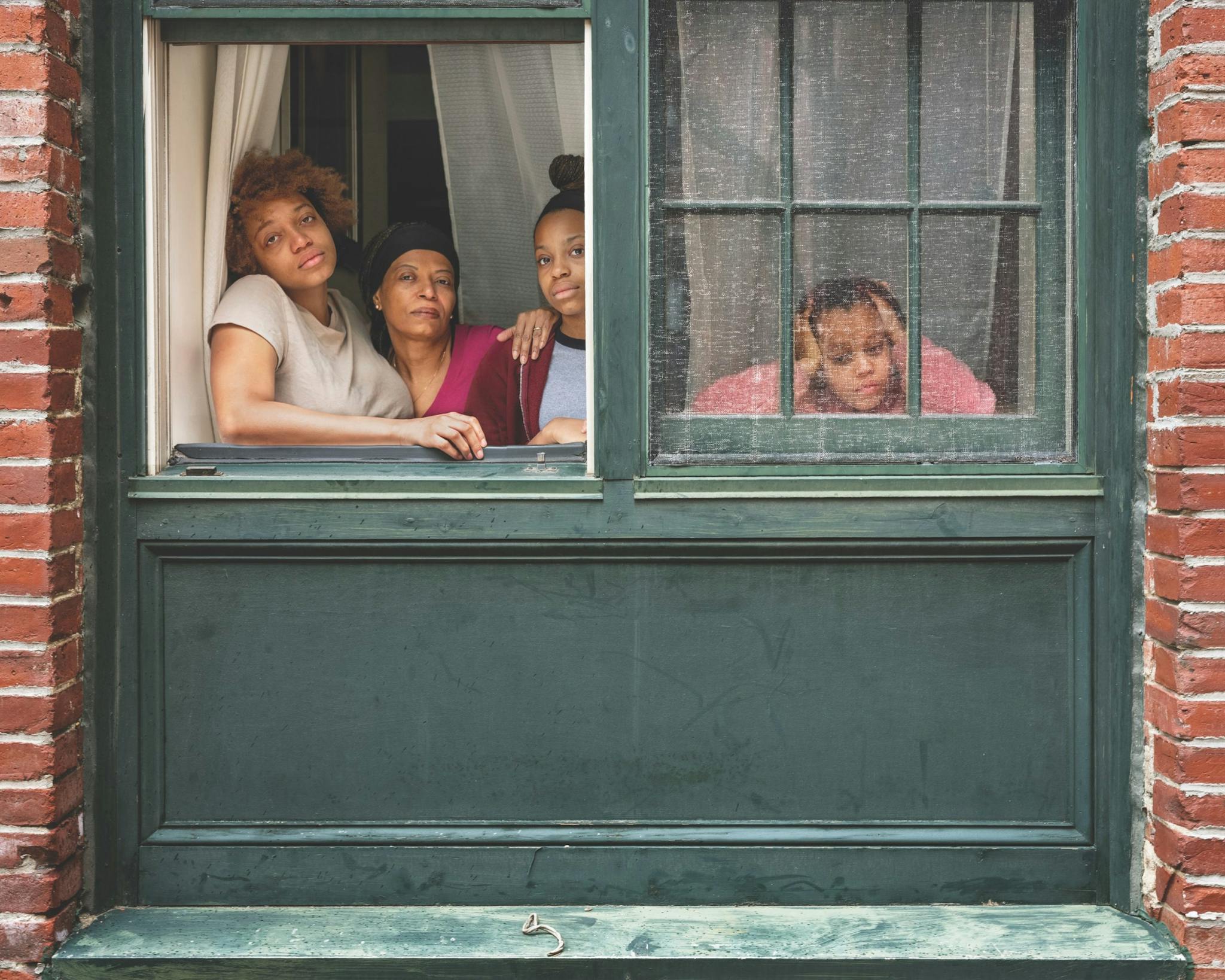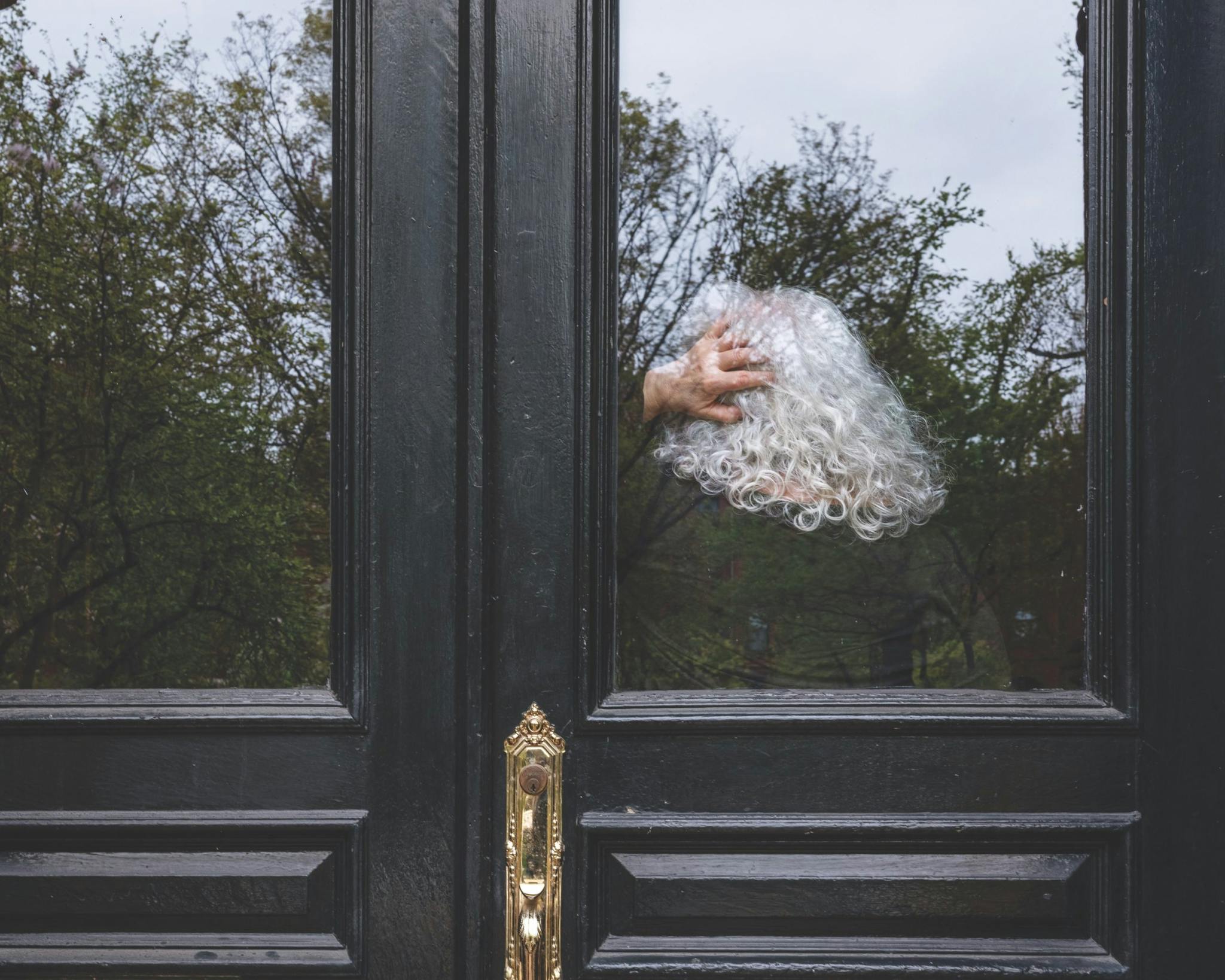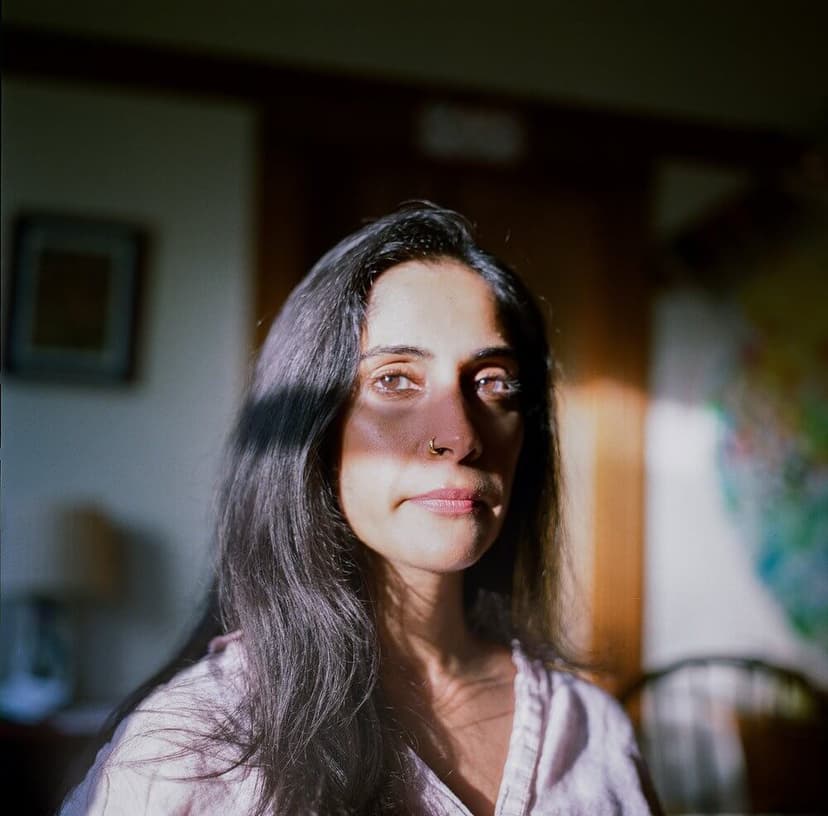A window, with its edges and its frame, defines a visible space. Look out your window and what do you see? What of you is seen? From the inside looking out, you will see life as it is lived on the surface. I look out the window of my city apartment and see the overgrown wisteria exhaling sparrows, neighbors walking their dogs, and cars on their way to elsewhere. All are in motion, all are just passing through. To them I am nothing but a shadow. If our eyes happen to meet, we only connect for a startling, fleeting moment.
In late March of 2020, Brookline-based photographer Rania Matar was at her kitchen sink when she looked up and saw her neighbor at her own kitchen sink. Two neighbors, mirrored, noticing each other for the first time. It was a serendipitous occurrence; in a few weeks, the spring trees would blossom and her neighbor’s window would be obscured, and Matar, who had been traveling around the US and to Lebanon to shoot photographs for her next project, SHE, could no longer travel due to the coronavirus pandemic. At home with her husband, her four adult kids, and their two cousins, she was spending a lot more time in the kitchen. When she wasn’t in the kitchen, she was in her studio, looking at 8 ½ × 11 prints of her photographs, spread out over the floor. Perhaps the time she spent looking at those prints made her see a photograph when she looked up and saw her neighbor across the yard. Inspired by their exchange, she put out a call on Instagram, offering to take portraits of Boston-area residents through their windows.
Over the next year, Matar set up over 130 portrait sessions, photographing individuals of all ages and gender expressions and families too—siblings, couples, parents with their children, toddlers holding their elder’s hand. Together, they are a study of the various moods and faces of isolation. Some portraits are watery, ethereal, and in others Matar uses her command of chiaroscuro to dramatic effect. Take this sequence of images in which the subjects chose to close their eyes. Lida, fingers grasping the pendant of her necklace, angles her face toward the sun, the copper of her hair haloed by the dull reflection of a tree. In another, Cyrus’s closed lids are swept with eyeshadow, calling our attention to his lipstick, the earring dangling from one ear, the bright crimson of his shirt. He has dressed up for this shoot, he is, indeed, posing, and he seems to be reveling in this moment of play, of capture, of communion. Matar uses the reflection of the glass to pick up the colors of the flowers outside. A deck comes into focus—slatted floors, a railing, pots of flowers, the corner of a table. Matar has given Cyrus a stage. In another portrait, Matar photographs a couple, Cam and Jared, from a distance. Entwined, their heads and cheeks touch. Seeing their ungloved hands and their unmasked faces so close, I felt punctured. When was the last time I had seen such a public display of affection by two strangers?
On Either Side of the Window was a new kind of project for Matar. In her decades-long career as a portrait artist, she has focused primarily on girlhood and womanhood, inspired by the coming of age of her own two daughters. In the first of these formal studies on female adolescence, A Girl and Her Room (2012), Matar takes us into the domestic spaces of teenage girls living in the US and in Lebanon, photographing them in the beautiful chaos of their becoming. The girls pose themselves, and often, they aren’t smiling. Matar notes in her project statement for L’Enfant-Femme (2016), in which she photographs young teens and preteen girls, that it’s by her request that they not smile in their portraits. How free those young women and girls must have felt when they realized that the adult in the room—the photographer with the camera, with the power—was asking them to imagine, alongside her, what their portrait could be like if they didn’t smile. The cover image of A Girl and Her Room is of a young woman named Christilla sitting sideways in a movie director’s chair, her toes pressed against her dresser. Behind her is a wall-sized poster of Marilyn Monroe. When the photograph was shown at the Museum of Fine Arts as part of the exhibition “She Who Tells a Story: Women Photographers from Iran and the Arab World” (2013), a viewer challenged the curator, Kristen Gresh, saying, “I thought this was supposed to be an exhibition of photography by Arab women?” Matar laughed while retelling the story, but it was clear she was rankled. What is a photograph by an Arab woman, of an Arab woman, supposed to look like? These are the kinds of questions she’s been battling since the beginning of her career.
Matar was born and raised in Lebanon by her Palestinian Christian father. She migrated to the US in 1984 when the civil war in Lebanon forced her to abandon her studies in architecture at the prestigious American University of Beirut. She transferred to Cornell University in New York to finish her degree and worked as an architect in the Boston area for several years until she had twins. Photography was a way for her to document her growing young family, a chance to stay connected to her visual training. Her relationship to the medium changed after the September 11th attacks and the subsequent discourse about the Middle East. “It felt like all my identities seemed at odds with each other…‘them vs. us.’ I was both. That was hard—up to that point, I wasn’t even thinking about any of that. I was working, having kids, moved into a new home, etc.” Her first book, Ordinary Lives (2009), collects Matar’s documentary photographs taken in Lebanon and the West Bank over several years. They include four interrelated bodies of work: The Aftermath of War (focusing on life in Lebanon after war); The Veil: Modesty, Fashion, Devotion or Statement; The Forgotten People, on life in Palestinian refugee camps; and The Arab Christians. There’s a jagged, fragmentary feel to the black-and-white images. Life spills over the edges. What is unseen but suggested is just as important as what is framed and captured. While portraits ask us to consider the individual first as an aesthetic subject, as holding systemic and global forces in their bodily expression, documentary photography asks the reverse—that we think of the setting first, and how the individual functions within it. The images in Ordinary Lives play upon a universal idea of what daily life looks like—neighbors chatting, a mother nursing her baby, girls looking at themselves in the mirror, kids playing in the street—and set it against the backdrop of refugee camps and war-torn cityscapes. Wielding her experience as a Lebanese American, Matar’s captured images seek to collapse the distance inherent in notions of “us vs. them.”
Windows, as a psychological and spatial boundary of private life, are in some ways a perfect visual articulation of “us vs. them.” We, inside, use the porous window to gaze upon those outside. It’s fitting then that Matar, who has used her art to unify, saw windows as a site for connection rather than separation. As she was inundated by strangers’ requests for her to take their portrait, her own process changed. Rather than using a medium-format film camera, she switched to digital, sensing that it was important for the photos to be immediately available to share. At first, she had expected to snap a quick photograph and leave, but sensing that her subjects had time and were enjoying themselves, she often stayed for hours. Her sensitivity, so crucial to building trust with the young, vulnerable subjects of her previous projects, had allowed her to see this time with her neighbors as more than a photo shoot.
How has the pandemic changed city life? How has it changed our relationship to one another? I imagine we’ll be asking these questions for a long time. My conversations with Matar mostly took place over July of 2021 at a precarious moment; the Delta variant and breakthrough cases were threatening to reverse the course we had begun toward normal. One evening, while I was working on this feature, a deep pink light penetrated my room, casting a rose shadow of my window on my wall. The fires in Canada and California had traveled over our shared atmosphere and reddened our piece of sky in the Northeast. A few weeks later, Lebanon suffered a complete economic collapse. The stories of the situation in Lebanon were harrowing: fuel shortages, hospitals without electricity, long lines at a bakery while people waited for bread. Matar was there, visiting her family. I thought of her often. Her latest photobook, SHE, had just been published. In it are women from Lebanon and the US, all in their early twenties, around the same age Matar was at the time of her migration. She had mentioned to me how in awe she was of this young generation. “They are the ones out on the streets, rebuilding Beirut,” she mentioned in one conversation. Her own son is among them. These days, as the world grows more fragile, I struggle with a desire to retreat from public life. To watch it all pass by. I think of Matar then. How she ventured out during the early days of the pandemic, calling forth her neighbors from the shadows of their homes, so they could greet her from their windows.
This feature was originally published in Issue 07: Rooting in the fall of 2021 with additional images.




